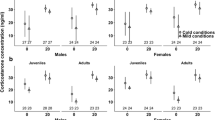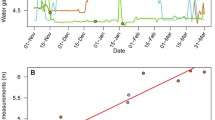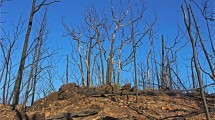Abstract
Due to global climate change, the winter conditions in the North are predicted to change, as the time with an intact insulating snow cover gets shorter or disappears altogether. For small mammals, this could cause exposure to strong temperature fluctuations and increased predation risk, inducing severe stress and leading to alterations in the physical condition and behavior. To test this, we exposed bank voles (Myodes glareolus) to different temperature regimes and cues of predator threat under laboratory conditions. The test animals experienced either a stable but cool temperature regime resembling the stable conditions under snow cover, or an unstable temperature regime with cold nights and warmer days simulating the climate change scenario with unstable winter. After 3 weeks, the animals were additionally exposed to owl calls or sounds of non-predatory bird species. Stress levels, activity, food consumption, and body mass were monitored. We observed that the voles exposed to unstable temperatures adjusted their normal, mostly nocturnal, and circadian activity pattern towards a more diurnal rhythm without any significant responses in their stress level. Introducing the sound manipulation elevated the stress levels in females but not in males. The sound-induced stress levels did not differ between the temperature treatments. However, the temperature regime tended to affect anti-predator behavior as individuals experiencing unstable temperatures and a threatening sound decreased their overall activity, unlike individuals under stable temperature treatments. It seems that behavioral plasticity in bank voles may diminish the risk of accumulation of stress in cases of multiple simultaneous stressors.
Significance statement
The future course of many ecosystems in the northern hemisphere has raised many questions as climate change is predicted to have notable consequences especially in these regions due to alterations in winter conditions. Our results suggest that these environmental changes could alter the circadian activity pattern and possibly, even the anti-predator behavior of bank voles. However, the adaptability and behavioral plasticity in this species may diminish the risk of pathological accumulation of stress effects.


Similar content being viewed by others
References
Banks PB, Norrdahl K, Korpimäki E (2000) Nonlinearity in the predation risk of prey mobility. Proc R Soc Lond B 267:1621–1625
Banks PB, Norrdahl K, Korpimäki E (2002) Mobility decisions and the predation risks of reintroduction. Biol Conserv 103:133–138
Beldomenico PM, Telfer S, Gebert S, Lukomski L, Bennett M, Begon M (2008) Poor condition and infection: a vicious circle in natural populations. Proc R Soc Lond B 275:1753–1759
Blumstein DT (2006) Developing an evolutionary ecology of fear: how life history and natural history traits affect disturbance tolerance in birds. Anim Behav 71:389–399
Boissy A, Bouissou MF (1994) Effects of androgen treatment on behavioral and physiological responses of heifers to fear-eliciting situations. Horm Behav 28:66–83
Boonstra R (2004) Coping with changing northern environments: the role of the stress axis in birds and mammals. Integr Comp Biol 44:95–108
Boonstra R, Dantzer B, Delehanty B, Fletcher QE, Sheriff MJ (2014) Equipped for life in the boreal forest: the role of the stress axis in mammals. Arctic 67:82–97
Borowski Z (2002) Individual and seasonal differences in antipredatory behaviour of root voles a field experiment. Can J Zool 80:1520–1525
Bronson FH (2009) Climate change and seasonal reproduction in mammals. Philos T Roy Soc B 364:3331–3340
Brown G, Shine R (2004) Effects of reproduction on the antipredator tactics of snakes (Tropidonophis mairii, Colubridae). Behav Ecol Sociobiol 56:257–262
Chichinadze K, Chichinadze N (2008) Stress-induced increase of testosterone: contributions of social status and sympathetic reactivity. Physiol Behav 94:595–603
Cichon M, Chadzinska M, Ksiazek A, Konarzewski M (2002) Delayed effects of cold stress on immune response in laboratory mice. Proc R Soc Lond B 269:1493–1497
Cooper WE, López P, Martín J, Pérez-Mellado V (2012) Latency to flee from an immobile predator: effects of predation risk and cost of immobility for the prey. Behav Ecol 23:790–797
Cornwell-Jones CA, Kovanic K (1981) Testosterone reduces olfactory neophobia in male golden hamsters. Physiol Behav 26:973–977
Daly M, Behrends PR, Wilson MI, Jacobs LF (1992) Behavioural modulation of predation risk: moonlight avoidance and crepuscular compensation in a nocturnal desert rodent, Dipodomys merriami. Anim Behav 44:1–9
Duchesne D, Gauthier G, Berteaux D (2011) Habitat selection, reproduction and predation of wintering lemmings in the Arctic. Oecologia 167:967–980
Eccard JA, Fey K, Caspers BA, Ylönen H (2011) Breeding state and season affect interspecific interaction types: indirect resource competition and direct interference. Oecologia 167:623–633
Edut S, Eilam D (2004) Protean behavior under barn-owl attack: voles alternate between freezing and fleeing and spiny mice flee in alternating patterns. Behav Brain Res 155:207–216
Eilam D, Dayan T, Ben-Eliyahu S, Schulman I, Shefer G, Hendrie CA (1999) Differential behavioural and hormonal responses of voles and spiny mice to owl calls. Anim Behav 58:1085–1093
George SL, Crooks KR (2006) Recreation and large mammal activity in an urban nature reserve. Biol Conserv 133:107–117
Halle S (2000) Voles—small graminivores with polyphasic patterns. In: Halle S, Stenseth NC (eds) Activity patterns in small mammals. Springer, Berlin, pp. 191–215
Hettena AM, Munoz N, Blumstein DT (2014) Prey responses to predator’s sounds: a review and empirical study. Ethology 120:427–452
Huey RB, Bennett AF (1990) Physiological adjustments to fluctuating thermal environments: an ecological and evolutionary perspective. In: Morimoto RI, Tissieres A, Georgopoulus C (eds) Stress proteins in biology and medicine. Cold Spring Harbor Laboratory Press, Cold Spring Harbor, New York, pp. 37–59
Jacob J, Brown JS (2000) Microhabitat use, giving-up densities and temporal activity as short-and long-term anti-predator behaviors in common voles. Oikos 91:131–138
Jylhä K, Fronzek S, Tuomenvirta H, Carter TR, Ruosteenoja K (2008) Changes in frost, snow and Baltic Sea ice by the end of the twenty-first century based on climate model projections for Europe. Clim Chang 86:441–462
Kaufman DW, Kaufman GA (1982) Effect of moonlight on activity and microhabitat use by Ord's kangaroo rat (Dipodomys ordii). J Mammal 63:309–312
Kohlhause S, Hoffmann K, Schlumbohm C, Fuchs E, Flügge G (2011) Nocturnal hyperthermia induced by social stress in male tree shrews: relation to low testosterone and effects of age. Physiol Behav 104:786–795
Korpimäki E, Hakkarainen H (2012) The boreal owl: ecology, behaviour and conservation of a forest-dwelling predator. Cambridge University Press, Cambridge
Kotler BP, Brown JS, Hasson O (1991) Factors affecting gerbil foraging behavior and rates of owl predation. Ecology 72:2249–2260
Laine LJ (2009) Suomen luonto-opas. WSOY, Porvoo
Lockard RB, Owings DH (1974) Seasonal variation in moonlight avoidance by bannertail kangaroo rats. J Mammal 55:189–193
Lovejoy TE, Hannah LJ (eds) (2005) Climate change and biodiversity. Yale University Press, New Haven, CT
Marchand PJ (1996) Life in the cold: an introduction to winter ecology. University Press of New England, Hanover and London
McDevitt RM, Speakman JR (1994) Limits to sustainable metabolic rate during transient exposure to low temperatures in short-tailed field voles (Microtus agrestis). Physiol Zool 67:1103–1116
McEwen BS (2004) Protection and damage from acute and chronic stress: allostasis and allostatic overload and relevance to the pathophysiology of psychiatric disorders. Ann N Y Acad Sci 1032:1–7
McEwen BS, Wingfield JC (2003) The concept of allostasis in biology and biomedicine. Horm Behav 43:2–15
McNamara J, Buchanan K (2005) Stress, resource allocation, and mortality. Behav Ecol 16:1008–1017
Merritt JF (1984) Winter ecology of small mammals. Carnegie Museum of Natural History, Pittsburgh
Mills LS, Zimova M, Oyler J, Running S, Abatzoglou JT, Lukacs PM (2013) Camouflage mismatch in seasonal coat color due to decreased snow duration. P Natl Acad Sci U S A 110:7360–7365
Moshkin MP, Novikov EA, Kolosova IE, Surov AV, Telitsina AY, Osipova OA (2002) Adrenocortical and bioenergetic responses to cold in five species of murine rodent. J Mammal 83:458–466
Ohashi H, Saito M, Horie R, Tsunoda H, Noba H, Ishii H, Kuwabara T, Hiroshige Y, Koike S, Hoshino Y (2013) Differences in the activity pattern of the wild boar Sus scrofa related to human disturbance. Eur J Wildl Res 59:167–177
Place N, Kenagy G (2000) Seasonal changes in plasma testosterone and glucocorticosteroids in free-living male yellow-pine chipmunks and the response to capture and handling. J Comp Physiol B 170:245–251
Preisser EL, Bolnick DI, Benard MF (2005) Scared to death? The effects of intimidation and consumption in predator-prey interactions. Ecology 86:501–509
Schradin C (2008) Seasonal changes in testosterone and corticosterone levels in four social classes of a desert dwelling sociable rodent. Horm Behav 53:573–579
Schultz LA, Collier G, Johnson DF (1999) Behavioral strategies in the cold: effects of feeding and nesting costs. Physiol Behav 67:107–115
Schwaibold U, Pillay N (2006) Behavioral strategies of the African ice rat Otomys sloggetti robertsi in the cold. Physiol Behav 88:567–574
Serreze MC, Walsh JE, Chapin FS III, Osterkamp T, Dyurgerov M, Romanovsky V, Oechel WC, Morison J, Zhang T, Barry RG (2000) Observational evidence of recent change in the northern high-latitude environment. Clim Chang 46:159–207
Sheriff MJ, Krebs CJ, Boonstra R (2011) From process to pattern: how fluctuating predation risk impacts the stress axis of snowshoe hares during the 10-year cycle. Oecologia 166:593–605
Sipari S, Haapakoski M, Klemme I, Sundell J, Ylönen H (2014) Sex‐specific variation in the onset of reproduction and reproductive trade‐offs in a boreal small mammal. Ecology 95:2851–2859
Sipari S, Haapakoski M, Klemme I, Palme R, Sundell J, Ylönen H (2016) Population sex-ratio affecting behavior and physiology of overwintering bank voles (Myodes glareolus). Physiol Behav 159:45–51
Stankowich T, Blumstein DT (2005) Fear in animals: a meta-analysis and review of risk assessment. Proc R Soc Lond B 272:2627–2634
Stien A, Ims RA, Albon SD, et al. (2012) Congruent responses to weather variability in high arctic herbivores. Biol Lett 8:1002–1005
Touma C, Sachser N, Möstl E, Palme R (2003) Effects of sex and time of day on metabolism and excretion of corticosterone in urine and feces of mice. Gen Comp Endocrinol 130:267–278
Trebatická L, Ketola T, Haapakoski M, Opperbeck A, Ylönen H (2010) Is fear a factor in voles? Short term physiological and behavioural response to predation stress. TOECOLJ 3:16–21
Viau V (2002) Functional cross-talk between the hypothalamic-pituitary-gonadal and-adrenal axes. J Neuroendocrinol 14:506–513
Wang D, Sun R, Wang Z, Liu J (1999) Effects of temperature and photoperiod on thermogenesis in plateau pikas (Ochotona curzoniae) and root voles (Microtus oeconomus). J Comp Physiol B 169:77–83
Wingfield JC (2013) The comparative biology of environmental stress: behavioural endocrinology and variation in ability to cope with novel, changing environments. Anim Behav 85:1127–1133
Wingfield JC, Sapolsky RM (2003) Reproduction and resistance to stress: when and how. J Neuroendocrinol 15:711–724
Wolkovich EM, Cook BI, Allen JM, et al. (2012) Warming experiments underpredict plant phenological responses to climate change. Nature 485:494–497
Ydenberg RC, Dill LM (1986) The economics of fleeing from predators. Adv Study Behav 16:229–249
Ylönen H (1988) Diel activity and demography in an enclosed population of the vole Clethrionomys glareolus (Schreb.). Ann Zool Fenn 25:221–228
Ylönen H, Eccard JA, Jokinen I, Sundell J (2006) Is the antipredatory response in behaviour reflected in stress measured in faecal corticosteroids in a small rodent? Behav Ecol Sociobiol 60:350–358
Ylönen H, Viitala J (1985) Social organization of an enclosed winter population of the bank vole Clethrionomys glareolus. Ann Zool Fenn 22:353–358
Zimova M, Mills LS, Nowak JJ (2016) High fitness costs of climate change-induced camouflage mismatch. Ecol Lett 19:299–307
Acknowledgments
We would like thank Professor Jack Millar and Professor Anders Angerbjörn for commenting on earlier versions of the manuscript, Teemu Käpylä and Suvi Lahtinen for their help conducting this experiment and Konnevesi research station staff; Jyrki Raatikainen, Risto Latvanen, Janne Koskinen, and Helinä Nisu for taking such a good care of our animals.
Author information
Authors and Affiliations
Corresponding author
Ethics declarations
Funding
This study was funded by the Academy of Finland (grant number 2100 00030 91) and the Finnish Cultural foundation (grant number CBE32BA).
Conflict of interest
The authors declare that they have no conflict of interest.
Ethical approval
All procedures performed in studies involving animals were in accordance with the ethical standards of the institution or practice at which the studies were conducted (Finnish State Committee for Animal Experimentation, License Code: ESLH-2008-05258/Ym-23).
Additional information
Communicated by C. Voigt
Rights and permissions
About this article
Cite this article
Sipari, S., Haapakoski, M., Klemme, I. et al. Changing winter conditions in the boreal forest: the effects of fluctuating temperature and predation risk on activity and physiological stress level in bank voles. Behav Ecol Sociobiol 70, 1571–1579 (2016). https://doi.org/10.1007/s00265-016-2165-4
Received:
Revised:
Accepted:
Published:
Issue Date:
DOI: https://doi.org/10.1007/s00265-016-2165-4




